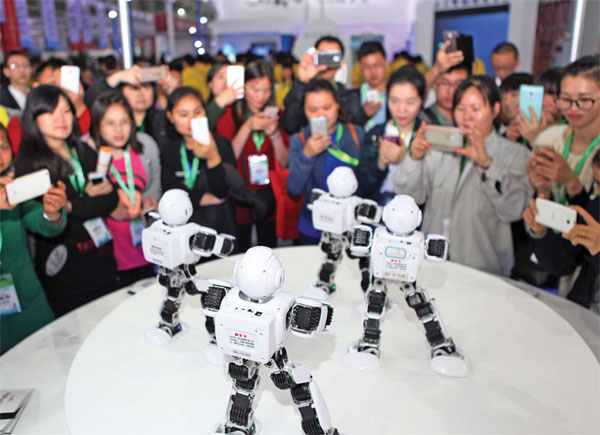Robots march to future
Technology wizards point the way to brave new world of automation
A gray robot with a strange shape attracts the attention of insiders from the robotic industry.
It is able to write calligraphy with a brush and is one of the star exhibits at the three-day China National Robotics Development Forum 2016 in Chongqing.
|
The China National Robotics Development Forum in Chongqing attracts many visitors. Provided to China Daily |
The forum was held for the second time in the southwest city, gathering experts in robotic theory and companies specializing in robot design and manufacture.
Apart from signing co-operation agreements and sharing advanced robotic technology with counterparts, some manufacturers treat the forum as a showcase for their most competitive products.
Liang Jinlong, sales manager of the Beijing Up-tech Harmony Co, which designs and makes the calligraphy machine, says the company mainly builds robots to be used for educational purposes in schools and universities. It also provides other services, such as highly-customized robots.
"For instance, the idea of a calligraphy writing robot, which is made up of over 1,000 parts, was actually raised by our clients themselves. We only provide the core embedded system and all the spare parts," he says.
Liang is confident about the future development of the company and the potential of the robot industry in China due to the increasing interest from the public and the encouraging policy of the government.
Paul Ni, a senior project manager at consulting firm Roland Berger, says despite a late start, the robot industry in China was enjoying a large and rapid boost thanks to favorable policies.
In recent years the public has also shown greater interest in robots and artificial intelligence than ever before, especially after some remarkable wins by the AlphaGo game-playing program against some top chess masters, Ni says.
Ni says lots of startups want to enter the industry and profit from the hot market - but doesn't think all of them are ready, either technologically or in terms of manufacture.
Sun Youxian, the former director general of Chinese Association of Automation, agrees with Paul, saying the industry is still facing challenges. Robotic has become a key part of the trend toward informatization and industrialization, and its technology has become the weather vane of the innovation and development of an intelligent society.
Liang says the company was set up in 2013 in response to robot fever. However, he is a little bit embarrassed when being asked about the revenue of the business, emphasizing the startup is paying more attention to winning more markets, rather than gaining profits.
A little robot from Guangdong Libin Medical Science and Technology may cause experts to be concerned in other ways. The company produces a medical recovery robot - but it's essentially just an app in a pad, built into a robot-shaped shell. Patients even have to input their own temperature and blood pressure manually.
However, Libin have done some innovative work in creating a smart ecosystem behind the robot. They have established co-operation agreements with The First Affiliated Hospital of Sun Yat-sen University. Doctors are ready to give medical suggestions and nurses are ready to use the device in patients' homes whenever needed.
Gao Zhiwei, deputy general manager of Libin, says the current robot could be regarded as the first generation. It doesn't have many robotic functions because the company is making lots of efforts to build up the smart ecosystem, which is the most important and most difficult function for such medical robots.
Gao says the company has 50 employees, 20 of whom are research personnel, and they have started to design the second generation robot with HD camera and some basic robotic functions, such as walking and voice control.
He is confident about the future of his product, saying as long as Chinese policy toward the robotic industry doesn't change too much, the recovery robot will represent the trend of the modern medical service.
Ni says although various startups poured into the robot market, the industry is still developing in a positive direction.
"It's good that Chinese robot companies have high confidence in themselves. But in my opinion, these enterprises should realize there is still a huge gap between them and the US and European robotic industries. Many of them still don't have the ability to compete in the market, both home and abroad," Ni says. "Therefore, improving and updating technology means a lot to them."
renqi@chinadaily.com.cn

























